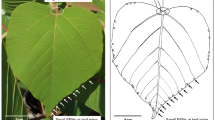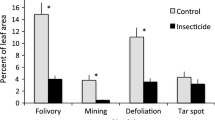Abstract
The effects of plant defenses on herbivory can differ among spatial scales. This may be particularly common with indirect defenses, such as extrafloral nectaries (EFNs), that attract predatory arthropods and are dependent on predator distribution, abundance, and behavior. We tested the defensive effects of EFNs in quaking aspen (Populus tremuloides Michx.) against damage by a specialist herbivore, the aspen leaf miner (Phyllocnistis populiella Cham.), at the scale of individual leaves and entire ramets (i.e., stems). Experiments excluding crawling arthropods revealed that the effects of aspen EFNs differed at the leaf and ramet scales. Crawling predators caused similar reductions in the percent leaf area mined on individual leaves with and without EFNs. However, the extent to which crawling predators increased leaf miner mortality and, consequently, reduced mining damage increased with EFN expression at the ramet scale. Thus, aspen EFNs provided a diffuse defense, reducing damage to leaves across a ramet regardless of leaf-scale EFN expression. We detected lower leaf miner damage and survival unassociated with crawling predators on EFN-bearing leaves, suggesting that direct defenses (e.g., chemical defenses) were stronger on leaves with than without EFNs. Greater direct defenses on EFN-bearing leaves may reduce the probability of losing these leaves and thus weakening ramet-scale EFN defense. Aspen growth was not related to EFN expression or the presence of crawling predators over the course of a single season. Different effects of aspen EFNs at the leaf and ramet scales suggest that future studies may benefit from examining indirect defenses simultaneously at multiple scales.



Similar content being viewed by others
References
Abramoff MD, Magelhaes PJ, Ram SJ (2004) Image processing with ImageJ. Biophotonics Int 11:36–42
Addicott JF, Aho JM, Antolin MF, Padilla DK, Richardson JS, Soluk DA (1987) Ecological neighborhoods—scaling environmental patterns. Oikos 49:340–346
Adjei-Maafo IK, Wilson LT, Thomson NJ, Blood PRB (1983) Effect of pest damage intensity on the growth, maturation, and yield of nectaried and nectariless cotton. Environ Entomol 12:353–358
Barton AM (1986) Spatial variation in the effect of ants on an extrafloral nectary plant. Ecology 67:495–504. doi:10.2307/1938592
Bentley BL (1977) Extrafloral nectaries and protection by pugnacious bodyguards. Annu Rev Ecol Syst 8:407–427. doi:10.1146/annurev.es.08.110177.002203
Bestelmeyer BT (2005) Does desertification diminish biodiversity? Enhancement of ant diversity by shrub invasion in south–western USA. Divers Distrib 11:45–55. doi:10.1111/j.1366-9516.2005.00122.x
Bronstein JL (1998) The contribution of ant–plant protection studies to our understanding of mutualism. Biotropica 30:150–161. doi:10.1111/j.1744-7429.1998.tb00050.x
Canada Natural Resources (2008) Yukon forest health report. Natural Resources, Ottawa
Chamberlain SA, Holland JN (2008) Density-mediated, context-dependent consumer resource interactions between ants and extrafloral nectar plants. Ecology 89:1364–1374. doi:10.1890/07-1139.1
Chamberlain SA, Holland JN (2009) Quantitative synthesis of context dependency in ant–plant protection mutualisms. Ecology 90:2384–2392. doi:10.1890/08-1490.1
Condrashoff SF (1962) A description of the immature stages of Phyllocnistis populiella Chambers (Lepidoptera: Gracillariidae). Can Entomol 94:902–909
Condrashoff SF (1964) Bionomics of the aspen leaf miner, Phyllocnistis populiella Cham. (Lepidoptera: Gracillariidae). Can Entomol 96:857–874. doi:10.4039/Ent96857-6
Connor EF, Taverner MP (1997) The evolution and adaptive significance of the leaf-mining habit. Oikos 79:6–25
Di Giusto B, Anstett MC, Dounias E, McKey DB (2001) Variation in the effectiveness of biotic defence: the case of an opportunistic ant–plant protection mutualism. Oecologia 129:367–375. doi:10.1007/s004420100734
Doak P, Wagner D, Watson A (2007) Variable extrafloral nectary expression and its consequences in quaking aspen. Can J Bot 85:1–9. doi:10.1139/b06-137
Heads PA, Lawton JH (1985) Bracken, ants and extrafloral nectaries. III. How insect herbivores avoid ant predation. Ecol Entomol 10:29–42. doi:10.1111/j.1365-2311.1985.tb00532.x
Heil M (2008) Indirect defence via tritrophic interactions. New Phytol 178:41–61. doi:10.1111/j.1469-8137.2007.02330.x
Heil M et al (2002) Reduced chemical defence in ant-plants? A critical re-evaluation of a widely accepted hypothesis. Oikos 99:457–468. doi:10.1034/j.1600-0706.2002.11954.x
Heil M, Hilpert A, Kruger R, Linsenmair KE (2004) Competition among visitors to extrafloral nectaries as a source of ecological costs of an indirect defence. J Trop Ecol 20:201–208. doi:10.1017/s026646740300110x
Huntzinger M, Karban R, Young TP, Palmer TM (2004) Relaxation of induced indirect defenses of acacias following exclusion of mammalian herbivores. Ecology 85:609–614. doi:10.1890/03-3056
Kenward MG, Roger JH (1997) Small sample inference for fixed effects from restricted maximum likelihood. Biometrics 53:983–997
Levin SA (1992) The problem of pattern and scale in ecology. Ecology 73:1943–1967. doi:10.2307/1941447
Mondor EB, Addicott JF (2003) Conspicuous extra-floral nectaries are inducible in Vicia faba. Ecol Lett 6:495–497. doi:10.1046/j.1461-0248.2003.00457.x
Ness JH (2003) Catalpa bignonioides alters extrafloral nectar production after herbivory and attracts ant bodyguards. Oecologia 134:210–218. doi:10.1007/s00442-002-1110-6
Nomikou M, Janssen A, Sabelis MW (2003) Herbivore host plant selection: whitefly learns to avoid host plants that harbour predators of her offspring. Oecologia 136:484–488. doi:10.1007/s00442-003-1289-1
Östman O, Ives AR (2003) Scale-dependent indirect interactions between two prey species through a shared predator. Oikos 102:505–514. doi:10.1034/j.1600-0706.2003.12422.x
Pemberton RW (1993) Observations of extrafloral nectar feeding by predacious and fungivorous mites. Proc Entomol Soc Wash 95:642–643
Rose USR, Lewis J, Tumlinson JH (2006) Extrafloral nectar from cotton (Gossypium hirsutum) as a food source for parasitic wasps. Funct Ecol 20:67–74. doi:10.1111/j.1365-2435.2006.01071.x
Rudgers JA (2004) Enemies of herbivores can shape plant traits: selection in a facultative ant–plant mutualism. Ecology 85:192–205. doi:10.1890/02-0625
Rudgers JA, Strauss SY (2004) A selection mosaic in the facultative mutualism between ants and wild cotton. Proc R Soc Lond B 271:2481–2488. doi:10.1098/rspb.2004.2900
Rudgers JA, Strauss SY, Wendel JF (2004) Trade-offs among anti–herbivore resistance traits: insights from Gossypieae (Malvaceae). Am J Bot 91:871–880. doi:10.3732/ajb.91.6.871
Rutter MT, Rausher MD (2004) Natural selection on extrafloral nectar production in Chamaecrista fasciculata: the costs and benefits of a mutualism trait. Evolution 58:2657–2668. doi:10.1554/04-009
Sendoya SF, Freitas AVL, Oliveira PS (2009) Egg-laying butterflies distinguish predaceous ants by sight. Am Nat 174:134–140. doi:10.1086/599302
Shelton AL (2005) Within-plant variation in glucosinolate concentrations of Raphanus sativus across multiple scales. J Chem Ecol 31:1711–1732. doi:10.1007/s10886-005-5922-9
Shroff R, Vergara F, Muck A, Svatos A, Gershenzon J (2008) Nonuniform distribution of glucosinolates in Arabidopsis thaliana leaves has important consequences for plant defense. Proc Natl Acad Sci USA 105:6196–6201. doi:10.1073/pnas.0711730105
Sugiura S, Abe T, Makino S (2006) Loss of extrafloral nectary on an oceanic island plant and its consequences for herbivory. Am J Bot 93:491–495. doi:10.3732/ajb.93.3.491
Trelease W (1881) The foliar nectar glands of Populus. Bot Gaz 6:284–290. doi:10.1086/325529
US Forest Service (2008) Forest health conditions in Alaska—2007: a forest health protection report. US Forest Service, Alaska Region R10-PR-18
Wagner D, Nicklen EF (2010) Ant nest location, soil nutrients, and nutrient uptake by ant-associated plants: does extrafloral nectar attract ant nests and thereby enhance plant nutrition? J Ecol 98:614–624. doi:10.1111/j.1365-2745.2010.01640.x
Wagner D, DeFoliart L, Doak P, Schneiderheinze J (2008) Impact of epidermal leaf mining by the aspen leaf miner (Phyllocnistis populiella) on the growth, physiology, and leaf longevity of quaking aspen. Oecologia 157:259–267. doi:10.1007/s00442-008-1067-1
Wooley SC, Donaldson JR, Gusse AC, Lindroth RL, Stevens MT (2007) Extrafloral nectaries in aspen (Populus tremuloides): heritable genetic variation and herbivore-induced expression. Ann Bot 100:1337–1346. doi:10.1093/aob/mcm220
Young BD, Wagner D, Doak P, Clausen TP (2010) Within-plant distribution of phenolic glycosides and extrafloral nectaries in trembling aspen, Populus tremuloides. Am J Bot 97:601–610. doi:10.3732/ajb.0900281
Acknowledgments
Many thanks are extended to S. Fischer, T. Fristoe, I. Lien, T. Miner, and S. Wilbur for their invaluable assistance in data collection; D. Sikes for assistance identifications and comments on an earlier version of this paper; G. Alpert and S. Cover for ant determinations; H. Proctor for mite determinations; M. Short and J. McIntyre for guidance with statistics; B. Young for insightful conversation; and L. Mortensen. This paper was improved thanks to extremely helpful comments made by three anonymous reviewers. Funding was provided by a National Science Foundation award (DEB 0543632) to D. Wagner and P. Doak.
Author information
Authors and Affiliations
Corresponding author
Additional information
Communicated by Colin Orians.
Electronic supplementary material
Below is the link to the electronic supplementary material.
Rights and permissions
About this article
Cite this article
Mortensen, B., Wagner, D. & Doak, P. Defensive effects of extrafloral nectaries in quaking aspen differ with scale. Oecologia 165, 983–993 (2011). https://doi.org/10.1007/s00442-010-1799-6
Received:
Accepted:
Published:
Issue Date:
DOI: https://doi.org/10.1007/s00442-010-1799-6




